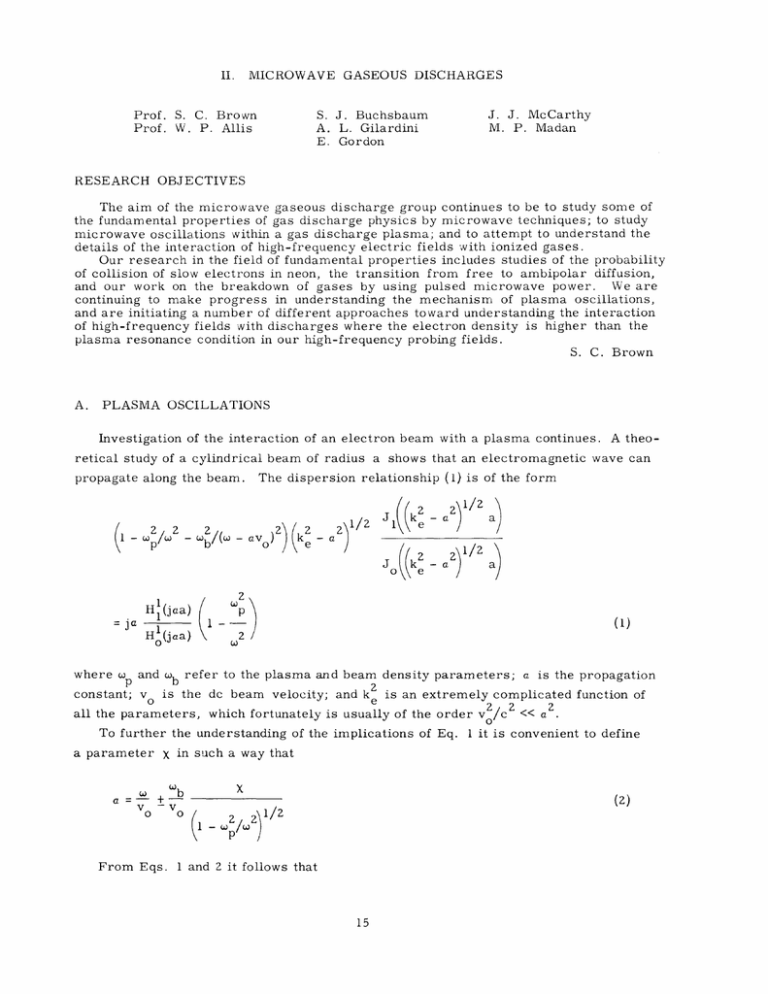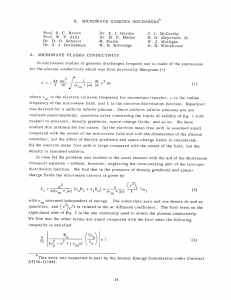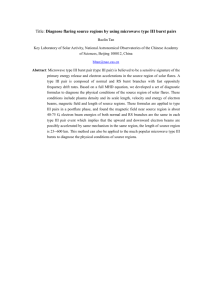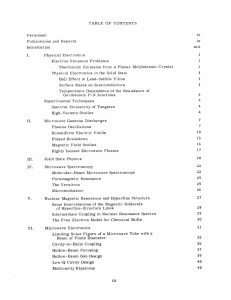Document 11085166
advertisement

MICROWAVE GASEOUS DISCHARGES II. J. J. McCarthy M. P. Madan S. J. Buchsbaum A. L. Gilardini E. Gordon Prof. S. C. Brown Prof. W. P. Allis RESEARCH OBJECTIVES The aim of the microwave gaseous discharge group continues to be to study some of the fundamental properties of gas discharge physics by microwave techniques; to study microwave oscillations within a gas discharge plasma; and to attempt to understand the details of the interaction of high-frequency electric fields with ionized gases. Our research in the field of fundamental properties includes studies of the probability of collision of slow electrons in neon, the transition from free to ambipolar diffusion, We are and our work on the breakdown of gases by using pulsed microwave power. continuing to make progress in understanding the mechanism of plasma oscillations, and are initiating a number of different approaches toward understanding the interaction of high-frequency fields with discharges where the electron density is higher than the plasma resonance condition in our high-frequency probing fields. S. C. Brown A. PLASMA OSCILLATIONS Investigation of the interaction of an electron beam with a plasma continues. A theo- retical study of a cylindrical beam of radius a shows that an electromagnetic wave can propagate along the beam. The dispersion relationship (1) is of the form 2 / (1- ? /(w - av ) k - k aZ - aZ1/2 a) 2 oe H1(jaa) S 2 2 H (jaa) where p 0 and cb refer to the plasma and beam density parameters; a is the propagation constant; v ° is the dc beam velocity; and k e is an extremely complicated function of all the parameters, which fortunately is usually of the order v /c << a To further the understanding of the implications of Eq. 1 it is convenient to define a parameter a a= o X in such a way that +-X Wb o (1 From Eqs. - X 2)1/2 1 and 2 it follows that (2) (II. MICROWAVE GASEOUS DISCHARGES) X1a j SHI(jaa) H (jaa) k2 -a o k )12 - a2 1/2 - a 21 For w greater than w , assume that a is real. be real, as is seen from Eq. 3. (3) -1/2 / It follows that if k2 < a , X will also From Eq. 2 it can then be seen that a is truly real, which corresponds to propagation with no change in amplitude. For w less than w , a and X are both complex. Thus, for high electron densities in the plasma, the wave will show both growth and attenuation. This is not a new result. Many investigators (2) have reached the same conclusion when considering a one-dimensional beam in an infinite plasma. Our results show that the same conclusion is valid for a beam of finite size. In order to test this result a tube that allows a premodulated beam to enter a plasma without the perturbing effect of a sheath is being constructed. It should be possible to detect any changes in amplitude and phase velocity as a function of plasma density. E. Gordon References 1. E. Gordon, Quarterly Progress Report, M.I.T., Oct. 15, 1955, pp. 11-13. 2. D. Bohm and E. P. B. HIGH-DENSITY MICROWAVE Gross, Phys. Rev. Research Laboratory of Electronics, 75, 1851 (1949). PLASMA An experimental apparatus different from the one described in previous progress reports is being constructed. A high-density plasma will be introduced into the region between the inner and outer conductors of a coaxial line through longitudinal slots cut in the line. These slots do not appreciably affect the propagation of microwaves along the line. The advantage of this arrangement over the previous one is that the region of interaction of the electromagnetic wave with the plasma is well defined. Also, it is expected that the plasma in this region of interaction will be fairly uniform. Theoretical investigation of the problem of interaction of electromagnetic with a high-density plasma is being continued. through nonuniform plasmas is being studied. waves In particular, the problem of propagation If the electron density in the plasma is nonuniform in one direction only (the more interesting case being the one in which this direction is perpendicular to the direction of propagation), it is possible to reduce the resulting wave equation to a boundary-value problem of the Sturm-Liouville type and (II. MICROWAVE GASEOUS DISCHARGES) solve for the lowest propagation mode by means of a variational principle. Numerical calculations are being performed for the relatively simple case of a plasma between two infinite planes, the electron density being a sine function of the distance between the planes. S. J. C. Buchsbaum STRIATIONS IN A MICROWAVE DISCHARGE In preparing a plasma for experiments described in the Quarterly Progress Reports (The of July 15, 1955, and October 15, 1955, a curious phenomenon was observed. same phenomenon was observed by other members of our laboratory several years ago under similar conditions of pressure, field strength, and frequency, but this is the first time it has been reported.) When an electrodeless discharge is produced by means of a relatively low-frequency (3 Mc/sec) field in hydrogen contained in a cylindrical glass bottle under proper conditions of pressure and field strength, the light emitted by the discharge is a very nonuniform function of the distance along the length of the bottle. The very bright doublet-like striations shown schematically in Fig. II-1 were observed to be disk-like in shape with the radius of the disk about half the radius of the glass bottle. The number of "doublets" increased with increasing pressure, six being the largest number that could be obtained. The doublet separation d and the distance between them, D, was a function of pressure that decreased slightly with increasing pressure. The largest value of d when only a single doublet was present was approximately 2 mm. This is just about the distance that an average electron would drift with the applied field during one half cycle. -Jz DISTANCE ALONG GLASS BOTTLE d I D DIRECTION OF APPLIED E Fig. II-1. Side view of the doublet-like striations in a cylindrical glass bottle. (II. MICROWAVE GASEOUS DISCHARGES) This suggests a mechanism for the production of the doublet-like striations: an electron cloud moving with the applied field gains sufficient energy during one half cycle to produce inelastic collisions at the end of the half cycle, stops on collisions, reverses its direction of motion with the reversed applied field, half cycle. and repeats this process every This mechanism would limit the appearance of the striations to just the right conditions of pressure (which can be measured) and field strength in the plasma (which could not be measured). This, in fact, was observed. The mechanism, however, does not explain why only a single doublet appears at lower pressures (approximately 5 mm Hg) and a larger number of doublets appears at a higher pressure (3 to 4 doublets at about 9 mm Hg). S. J. D. Buchsbaum PULSE BREAKDOWN IN GASES A considerable amount of experimental work has been done on the cw breakdown of gases at microwave frequencies, but the complex phenomena of pulse breakdown have not been thoroughly investigated. Investigation of pulse breakdown was started (Quar- terly Progress Report, Oct. 15, 1954) and a study has been made of the effect of various pulsewidths and repetition frequencies. This work is being extended in order to get more information about the fundamental processes involved in pulse breakdown. At high repetition frequencies the initial number of electrons left over from the previous pulse influences the time required for the breakdown. At low frequencies practically no influence is felt from a previous pulse. Between these extremes lies a critical frequency dependent on the pressure and pulsewidth below which the diffusion rate is such that the electron density decays completely during the off time and the preceding cycles contribute nothing to the breakdown. For such a case the breakdown is observed to be random, the time depending solely on the existing, initial electron density distribution and electric field. It was considered desirable to determine the transition frequency because it defines the limit to the regions of single-pulse and multipulse breakdown. The decay of electron density is given by n = n exp Dt where n o is the initial electron density, n is the density after a time t, polar diffusion coefficient, Da is the ambi- and A is the diffusion length dependent on the geometry of If we assume that the electron density decays by ambipolar diffusion only, from an initial value of 1010 electrons/cc to a density of 107 electrons/cc, and that 2 -1 DaP = 700 cm sec - mm Hg for hydrogen in a cavity of A = 0. 2, we can calculate the cavity. (II. MICROWAVE GASEOUS DISCHARGES) O x 0 LJ . w LnI i wI Ld LL Mn Ld 30 p(MM Hg) Transition frequency as a function of pressure for different pulsewidths. Fig. 1-2. the critical frequency for a given pulsewidth and pressure. The same frequency can be determined experimentally by observing the breakdown at a fixed pressure as a function of the repetition frequency, and noting the frequency at which the breakdown becomes random. A comparison of theoretical and experimental results is made in Fig. 11-2. agreement is The satisfactory, taking into account the fact that the theoretical curve is based on the assumption that the density n is 1010 electrons/cc. A slight variation in this numerical value brings the theoretical and experimental curves into closer agreement. M. E. MICROWAVE P. Madan, J. J. McCarthy INVESTIGATION OF NITROGEN AFTERGLOW Measurements of the conductivity ratio (the ratio of the real part to the imaginary part of the microwave electron conductivity), discharge, enable the determination performed in the afterglow of a pulsed (1, 2) of the collision probability for momentum transfer of slow electrons in a gas. The average electron energy is varied by applying a microwave electric field, and the collision probabiliy can be determined as a function of the electron energy. The (II. MICROWAVE GASEOUS DISCHARGES) theoretical relation between the electron energy and the applied field will be known in the absence of inelastic collision (3). In the thermal-energy region this is true for rare gases but not for molecular gases that have rotational and vibrational excitation levels. As a consequence, to determine the electron energy as a function of the field we have to know the so-called fractional loss factor, that is, the fraction of the energy difference between the electron and the gas that is transferred in a collision. Our discussion suggests a microwave method for measuring this unknown factor. The loss factor can be computed when we have a method for measuring the average electron energy corresponding to a known applied electric field. With proper calibration, easily performed by inserting the plasma in an oven and varying the gas which is temperature in a known way, the conductivity ratio can be used as the measure of the electron energy. Nitrogen was chosen as the first gas for measurement. For reasons given in refer- ence 1, the gas was contained in a cubical quartz bottle centered in a microwave cavity. The measurements without the heating field showed an unexpected effect: the con- ductivity ratio was found to be an increasing function of the power and pulselength in the breakdown field. This result suggests that the temperature is higher when the average breakdown power is higher. Successive measurements were performed for the case of a plasma filling the entire cavity; in this case the conductivity ratio was independent of the breakdown power. Unfortunately, when the plasma fills the entire cavity it is difficult to use a heating field because nonuniformities of the field make it necessary to introduce complicated correction factors into the theory. Since these correction factors depend upon the electron-density distribution in the cavity, we must know what mechanism is effective in controlling the electron-density decay in nitrogen afterglow. Measurements of the electron-density decay show that other factors beside ambipolar diffusion and recombination must be found to explain the features of the decay. Lr terms of recombination we have a higher recombination coefficient when the pulselength for breakdown is shorter and this effect is present in both cases: when the plasma fills the entire cavity and when the gas is contained in a quartz bottle. An increase in tem- perature decreases the apparent recombination coefficient, but the decrease is not proportional to the inverse of the temperature, as we would expect for a real recombination coefficient. These experimental results suggest that attachment to impurities may be the dominant electron loss mechanism. This could be explained by assuming that a very small amount of impurity (probably oxygen) was present in the nitrogen (a commercial troscopically pure AIRCO sample was used). spec- A longer breakdown pulse removes more impurities (we consider that an impurity molecule is removed when it is no longer (II. capable of attachment) and, consequently, MICROWAVE GASEOUS DISCHARGES) the afterglow decay is slower. Our next efforts will be directed toward improving the purity of the gas. A. L. Gilardini References 1. L. Gould and S. C. 2. Quarterly Progress Report, July 15, 1955, p. 14. 3. H. Margenau, Phys. Rev. 69, Brown, Phys. Rev. 95, 897 (1954). Research 508 (1946). Laboratory of Electronics, M. I. T.,





